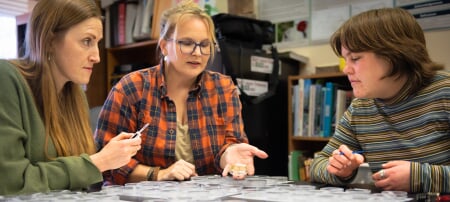Climate Change Liability: How Renewables Can Help Protect Energy Companies

Climate change lawsuits are becoming more and more likely, but adopting renewable energy could help mitigate that. A new study from Michigan Tech researchers reviewed how climate-related liability for energy companies is calculated and how it could be prevented. The results will be published in Renewable and Sustainable Energy Reviews (preprint available).
Joshua Pearce, an associate professor of electrical engineering and materials science at Michigan Tech, led the research.
“Historically, the lack of knowledge of potential liabilities from climate change has kept energy companies from including it in decision making,” Pearce says. “A review of the recent literature shows such a short-sighted approach is no longer tenable.”
Climate Litigation
Pearce and his co-author Negin Heidari, a graduated master’s student of Pearce’s, reviewed the seven published methods of assigning liability for emitters. They identified the top ten emitters in the US, and explored potential liabilities, looking in-depth at a single case-study company. They then compared the results of the fractional liability from only natural disasters within the US for a single year to a sensitivity to the future costs of carbon emissions from other sources of emission-related liability.
If carbon emission lawsuits become prevalent, the potential liability is an important criterion for investors. “We were shocked to find that common shareholders of the case study company would see a reduction in their profits of 18 percent compared to emissions liability related to only natural disasters in the US from a single coal-fired power plant,” Pearce says.
That profit reduction could be greatly magnified with climate change’s global impacts, stemming from eroding shorelines, rising seas and other hazards. Pearce points out that the poor in developing countries are most at risk, but “realistically, it is going to be the rich who are able to fund protracted climate-related lawsuits.”
The study focused on emitters in the US, but the impacts of climate liability could be felt globally. In fact, Pearce and Heidari found that organized international litigants already exist. For example, the results show that potential liability for climate change for the Alliance of Small Island States, whose members have already threatened lawsuits, could be over $570 trillion if they are forced to abandon their entire countries to rising sea levels and storm surges.
Renewable Energy
The potential litigation provides incentive for putting more renewable energy technology in place. Solar, wind, wave energy and other renewables could mitigate the flood of lawsuits, helping energy companies prevent considerable losses.
Energy companies can radically reduce their climate change-related liability by transitioning to lower cost renewable energy technologies such as solar photovoltaics, like the ones above at Michigan Tech’s Keweenaw Research Center. Because of steep cost declines recently, solar panels often produce less expensive electricity than traditional fossil fuels plants. Renewable energy makes for a sunnier option than years spent in court mitigating climate change liability.
Michigan Technological University is an R1 public research university founded in 1885 in Houghton, and is home to nearly 7,500 students from more than 60 countries around the world. Consistently ranked among the best universities in the country for return on investment, Michigan's flagship technological university offers more than 185 undergraduate and graduate degree programs in science and technology, engineering, computing, forestry, business, health professions, humanities, mathematics, social sciences, and the arts. The rural campus is situated just miles from Lake Superior in Michigan's Upper Peninsula, offering year-round opportunities for outdoor adventure.




Comments